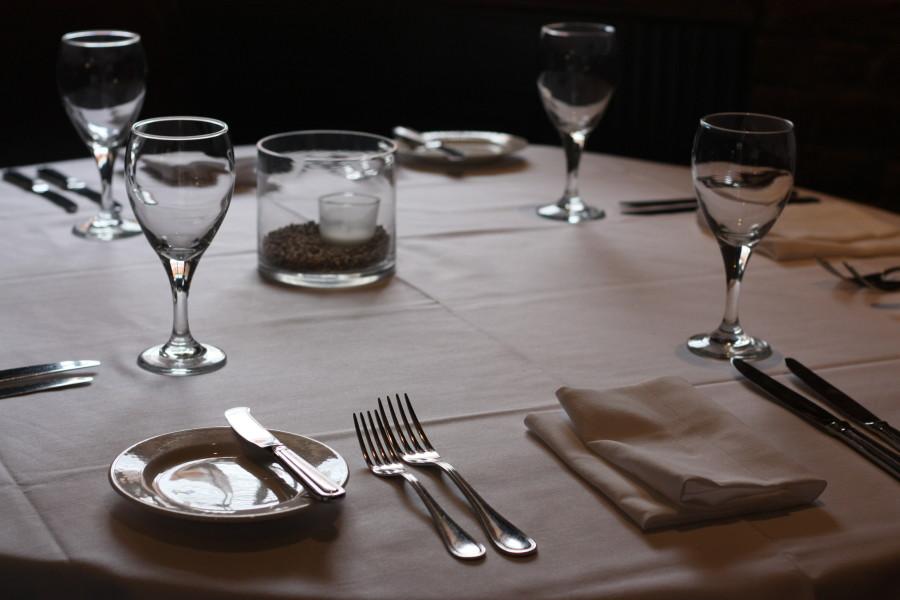Fine dining etiquette 101
October 10, 2015
You’re sitting at a fine dining establishment, and you notice there are four forks and two spoons. This is the swankiest restaurant you have ever had the luxury of going to and you don’t know what to do with your three other forks. You are too prideful and embarrassed to ask for help so you attempt to wing it. Next thing you know, everyone has napkins on their laps and you are slouching over your plate with elbows on the table.
In order to avoid embarrassing yourself in front of friends, dates and future employers, these fine dining tips will help guide you from eating chips on the couch to attending a black-tie event.
1. Dress appropriately – How you are dressed can say a great deal about you. For men, slacks are a must and should be accompanied with at least a dress shirt, tie, belt and polished dress shoes. Anything more than this is usually optional and depends on the occasion. Suits are perfectly acceptable and show that you came with the right mindset. For women, business attire and up is a must. This means there should be no short skirts, tight clothes, crop tops or ripped clothing. Be sure to have your clothes ironed because showing up with wrinkled clothes tells your party that you were too lazy to spend 10 minutes to iron them. Jeans should never make an appearance for either gender at a formal dinner party, so keep them at home.
2. Chew with your mouth closed and do not talk with food in your mouth – This tip should be self-explanatory; yet in 2015, people still do not have the etiquette to avoid chewing with their mouth open and talking while eating. It is unflattering to look at, makes tons of noise and makes you look like a slob. A proper way to allow you the ability to talk is to take smaller bites of food. No longer will you have to take a minute to chew your food just to answer a question at dinner.
3. Proper posture prevents poor performance – When eating at a fancy restaurant, one should avoid slouching in your seat and having your face hover directly over your plate. Use your utensils and bring the food to you and not the other way around. Also, never slurp your food. Ever.
4. ALWAYS say “thank you, please, and excuse me” – Sometimes these three polite words are all that you need in order to make yourself appear like a fine dining master.
5. Utensils – There are typically three types of forks at a formal dinner; salad fork, dinner fork, and the dessert fork. The forks are arranged from left to right, corresponding with each dish. First fork on the left is the salad fork, dinner fork in the middle and dessert fork last. The largest of the forks will be the dinner fork. There are two types of spoons called the soup spoon and a teaspoon. The teaspoon is the smaller of the two and is usually placed on the right side of the plate. The soup spoon is placed on the far left. Lastly, there is a dinner knife and a butter spreader. Along with the utensils, you will often find a soup bowl over your dinner plate.
6. Napkin – Place your napkin on your lap within one minute of sitting at the table to dine. Unless you are a child, there should be no reason for you to tuck a napkin into your shirt collar. A napkin is a napkin and it is not to be used as a bib. The main purpose of a napkin is to allow the person to remove leftover food from around their mouth. The secondary purpose is to protect your pants from spills. Use your napkin as needed and when you are finished with your meal, place the napkin neatly to the left of your plate.
7. When to start eating – This one is tricky and should be approached on a case-by-case basis. The easiest answer is that you should begin eating when others around you do. However, if others are away from the table and hot food is being served in front of you, then you should at least wait until two people are seated to begin. The one thing to remember is that you should never eat alone, but eat hot food while it is still hot.
8. Elbows/reaching – While the meal is in progress, you should try to avoid placing elbows on the table. However, when there is no food on the table, it is acceptable to place your elbows on the table when engaging in conversation. Apart from having elbows on the table, reaching across the table is never acceptable. If something is beyond your reach, kindly ask someone nearby to pass you the item you desire.
9. How to signal you are finished – The proper way to signal that you are finished with your meal is to place your knife and fork in the 4:20 position. Your fork should be closest to you with tongs pointed up, the knife with its cutting edge facing the fork’s tongs. This signals to the waiter or host that you are finished with your meal and it is also conveniently the most stable position for your silverware.
So feel free to iron out those fancy pants that have been sitting in the back of your closet since your graduation because you have now graduated from the fine dining etiquette guide 101. Enjoy your meal!








The Maroon • Nov 13, 2015 at 3:08 pm
Hello Paige.
Thanks for the compliment! It was enjoyable to write this article. I would respond to the catering company with common courtesy. Use your please and thank you’s to show your appreciation for their service.
-Gabriel Garza
Paige Smith • Oct 15, 2015 at 9:56 am
I really like this simple guide of formal dining tips. Although most of this is self explanatory there are still a few things that stood out to me. One question I have is how do you respond to the catering company as they serve you?